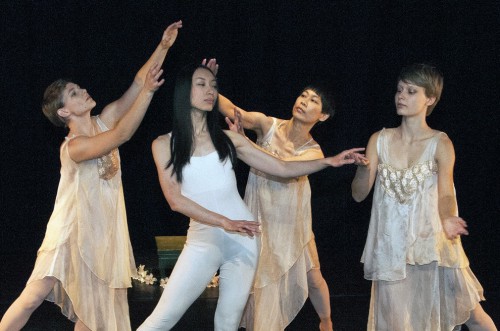
THERE is a moment during this program when visiting Taiwanese dancer, Christopher Chu, performs a poignant solo entitled “Memory Lost” to the music of Liszt’s “Liebestraum”.
It depicts a dancer who can no longer remember his steps, and is the only item on the program not choreographed by Elizabeth Cameron Dalman. Fortunately, Dalman suffers no such affliction, as evidenced in her meticulous recreation of all the other items, some dating back as early as 1966.
An important figure in Australian contemporary dance history, Dalman founded the Adelaide Dance Theatre in 1965 and the Mirramu Dance Company in 2002. She continues to maintain a busy schedule, choreographing, teaching and mentoring in Australia and overseas. She has a particularly close association with the Taipei National University and the annual Tsai Jui-Yueh International Dance Festival, and six Taiwanese dancers participate in this program.
In a performance presented without interval, seven items were shown from a possible 12 listed in the program. The rest will be included in other performances throughout the season. All were presented simply on a black-draped stage, with minimal props, sensitive lighting and, in some cases, costumes that appeared to be the originals.
Created in 1966 and danced to the songs of folk group, Peter, Paul and Mary, “This Train” was originally a suite of seven short dances. Dalman chose three of these dances to open the program. They were given spirited performances by Miranda Wheen, Janine Proost, Vivienne Rogis, Fu-Rong Chen and Ming-chu Yu, and were particularly interesting inclusions because they contain many of the hallmarks of Dalman’s open, energetic choreographic style.
Another work, “Generation Gap”, choreographed in 1968, also used the songs of Peter, Paul and Mary and contained powerful solos in which Wheen and Rogis shone.
In her entertaining introductions, given before each item, Dalman revealed how she came to form a close association with Peter, Paul and Mary. She shared, too, how, also in 1968, her fascination with Peter Sculthorpe’s music led to the creation of “Sun & Moon”, superbly danced by Yi-ching Chen and Fu-rong Chen, and how in 1987, she created for herself, a solo, “Woman of the River”, to the music of the Penguin Café Orchestra, which she has now gifted to dancer, Hsiao-Yin Peng, who went on to perform it exquisitely.
Dalman’s irrepressible sense of humour was to the fore in her cheeky, 1969 satirical work, “Homage to Botticelli”, gleefully interpreted by the company, and featuring Yi-chin Chen as Venus exhibiting a graceful serenity that must surely rival that of the original painting.
The program ended with excerpts from “Silk”, a work created by Dalman in 2002 for Mirramu. It featured Christopher Chu in a startling butoh-inspired silkworm solo, and concluded with Dalman herself performing a spectacular Loie Fuller-style solo in which she manipulated huge silk wings in a touching interpretation of the life-span of a silkmoth.
Dance students and, indeed, anyone with even a passing interest in Australian dance history should flock to “Fortuity”, not only for the fascinating and entertaining glimpse it offers into the development of contemporary dance in Australia, but also for the opportunity to be in the company of one Australia’s most important and passionate dance pioneers.
Who can be trusted?
In a world of spin and confusion, there’s never been a more important time to support independent journalism in Canberra.
If you trust our work online and want to enforce the power of independent voices, I invite you to make a small contribution.
Every dollar of support is invested back into our journalism to help keep citynews.com.au strong and free.
Thank you,
Ian Meikle, editor




Leave a Reply